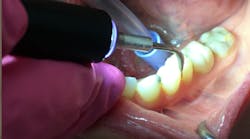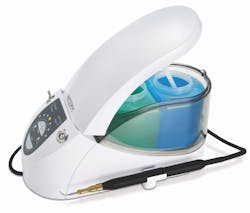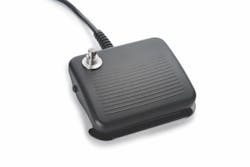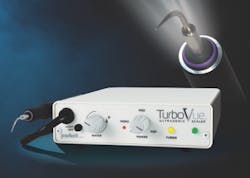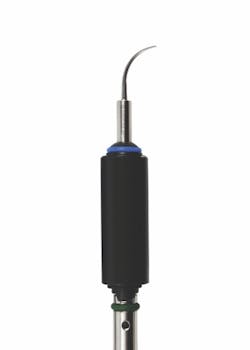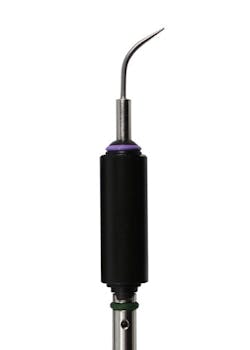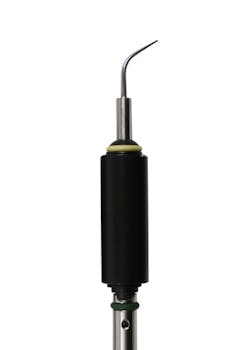I have been practicing dental hygiene for a long time and have used various types of ultrasonic or sonic scaling units and inserts. While all are effective in removing plaque, calculus, and stains, every company’s devices have unique designs and features. (1)
When choosing an ultrasonic scaling unit, my preferences are for it to be intuitive to use, be comfortable for both the operator and the patient, and offer enough variability in power settings and insert design so treatment can be tailored for each patient.
I recently had the opportunity to work with two ultrasonic scaling units that met my criteria: the Integra and TurboVue magnetostrictive ultrasonic scaling units from Parkell Inc. Both of these scalers “do the job” for performing nonsurgical periodontal therapy, and they have a couple of similarities as well as some distinct differences.
The Integra Integrated Scaling System
The Integra may be one of the most versatile ultrasonic scalers that I have ever used (figure 1). First, this unit can be connected to an outside water source (i.e., operatory water or a contained bottle system), and it contains two bottle reservoirs for either distilled water or medicaments (e.g., chlorhexidine or other irrigants). This unique feature allows me to use operatory water for scaling, then irrigate a localized area using a medicament in one of the reservoir bottles.
Figure 1: The Integra Integrated Scaling System
One benefit to this unit—especially for those who provide mobile dental care in hospitals or nursing homes—is that it is completely self-contained and portable because of the reservoir system. We recently had a situation in which we needed to transport the Integra from one operatory to another. We had the unit on a mobile cart, wheeled it into the operatory where doctor used it to aid in removing a broken implant screw, and then wheeled the unit right back to my operatory within minutes!
Another convenience of the unit is that it accepts both 25-kHz and 30-kHz ultrasonic inserts—including those made by Parkell as well as other compatible brands. The unit automatically adjusts its frequency to accommodate the insert.
The power can be adjusted on the touchpad or with the knob located on the foot pedal (figure 2). If you like to work hands-free, or if the unit is out of reach while you’re scaling, the foot pedal adjustment is terrific! There are seven power settings on the Integra: two low-power perio settings, three midrange settings for conventional scaling, and two high-power settings for removing tenacious calculus. The settings are color coded by lights on the front panel. But the coolest thing about the power settings is that there is a turbo mode! Let’s say that you’re scaling at a low- or medium-power setting, and you find a tough deposit. Instead of messing with the current setting, you can depress the foot pedal to boost to high power. After removing the hard deposit, you can lighten up on the foot pedal, and the unit will resume the low- or medium-power mode that you were originally using.
Figure 2: The Integra's foot pedal
The Integra doesn’t have an on/off switch, but it does have a sleep mode and will conserve energy when not in use for a period of time. To activate it again, just press any button on the panel, and it will be back on and ready to go.
The TurboVue Illuminated Ultrasonic Scaler
Parkell recently introduced this new ultrasonic scaler, and I think it will be revolutionary to hygiene (figure 3). Don’t get me wrong—I liked what the Integra offered, but when I got my hands on the TurboVue, all I could say was “wow!”
Figure 3: The TurboVue Illuminated Ultrasonic Scaler
As I mentioned before, there are similarities between the Integra and the TurboVue scalers. Both have removable sheaths that can be autoclaved, both have the turbo mode, and the TurboVue’s power settings are virtually the same as the Integra’s. The different power modes on the TurboVue aren’t indicated by colored lights, however, with the exceptions of the low-power perio mode and turbo mode. But the power of each setting is identical.
So, I’m sure you’re wondering what the “wow” factor is for the TurboVue, right? Well, this unit has a light built into the handpiece! The TurboVue has LED lights in the handle, and the inserts have a glass sleeve that transmits that light right down to the tip of the insert (figures 4–5). Even if you use a light on your loupes, this thing is unbelievable at shedding light into the toughest areas to see.
Figures 4–5: An ultrasonic without illumination, compared to an ultrasonic with illumination
The unit only accepts 30-kHz inserts, and it comes with three light-transmitting inserts—a Perio, a Universal, and a Burnett (figures 6–8). If you want, you can also use any other compatible 30-kHz inserts, such as those from Dentsply or Hu-Friedy, for example. The light won’t be the same with other inserts, but you’ll still have more light than you would if there wasn’t a light in the handpiece.
Figures 6–8: The Perio (left), Universal (center), and Burnett (right) light-transmitting 30-kHz inserts
When I first got the TurboVue, the Parkell rep told me that because of the LED lights, the handpiece may feel a bit warmer than a normal scaler’s handpiece, and the water coming out of the tip may also be slightly warmer. I actually found this to be a benefit because it was more comfortable for my patients. Some of my temperature-sensitive patients didn’t need to be anesthetized beforehand. For the patients who needed anesthetizing, I used Dentsply Pharmaceutical’s Oraqix (2.5% Lidocaine and Prilocaine periodontal gel) instead of the traditional local anesthetic.
I will say, however, that I did use a little more water through the TurboVue handpiece to make sure that everyone was comfortable and that the tip wouldn’t be too warm. My suggestion is that if you already have a water heater attached to your operatory line, you may want to monitor it to make sure that the water doesn’t get too warm for your patients. I happen to have a water heater for my waterline, and it was just fine. Like any new device, you may want to set it up and run through using it before you use it on any patients—that’s just good common sense.
Conclusion
Although I have found that many ultrasonic scalers are capable of effectively removing plaque, calculus, and stain, I appreciate that both the Integra and the TurboVue have handles that accept many of my existing inserts. Both ultrasonic scalers offer a multitude of settings that can be managed by hand or with the foot pedal. The self-contained water compartments of the Integra are especially useful when medicaments are used for irrigation or if portability is important, and the TurboVue’s illuminated inserts drastically improve visibility.
So, there you have it . . . two ultrasonic scalers that I’d be happy to work with any day of the week! The needs of your office and your patients will help you decide which one is more suitable for you. Up until this point, I had heard of Parkell, but I never had any experience with their products. Now, I can say that what I’ve heard about the company is true: They manufacture quality products at reasonable prices, and that’s why the company has been around forever.
Reference
1. Drisko CH. Root instrumentation: Power-driven versus manual scalers, which one? Dent Clin North Am. 1998 Apr;42(2):229-244.
______________________________________________________________________________________________________________
Editor's Note: This article first appeared in Pearls for Your Practice: The Product Navigator. Click here to subscribe. Click here to submit a products article for consideration.
______________________________________________________________________________________________________________
Diane Proudy, RDH, is a dental professional whose goal is to help patients obtain and maintain optimal health—not just in terms of dentition but overall health. She graduated from Middlesex Community College with an associate's degree in dental hygiene in 2006. This is a second career for her; prior to becoming a hygienist, she worked in a manufacturing field for 20 years as a quality control inspector. She currently practices in three dental offices: Salem Dental Arts with Pamela Maragliano-Muniz, DMD; with a periodontist; and with a general dentist. She has a 21-year-old daughter, and she enjoys cooking and spending time at the beach.
